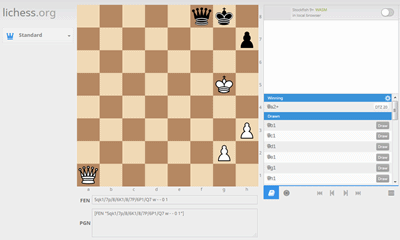Seven-piece Tablebase on Lichess
Almost since its beginning, this blog has taken an interest in chess tablebase technology, where endgames with a limited number of pieces are solved perfectly. The latest news opens an entirely new channel of investigation: 7-piece Syzygy tablebases are complete (lichess.org; 'Use the world's first free 7-piece tablebase on Lichess!'). The announcement started,
Congratulations to Bojun Guo (aka noobpwnftw) and Ronald de Man (aka syzygy) for completing the first free 7-piece tablebase and generously sharing it with the world! Lichess now provides online access on the analysis board and in studies, practice against tablebases, a public API, and a mirror for downloading the full tablebase files.
For the accompanying discussion, see General Chess Discussion / 7-piece Syzygy tablebases, with more links to other resources.
Six-piece tablebases are useful but somewhat limited. When we exclude the two Kings that are present in every position, we are left with four pieces, which are not sufficient for evaluating many positions where the stronger side has the advantage of a Pawn. Six-piece tablebases are most interesting for positions with unbalanced material, like R+P:B+P. With seven-piece tablebases, we suddenly have a tool for examining positions like R+2P:R+P, which are notoriously difficult to analyze.
Lately I've been interested in Queen endgames, because their outcomes -- win or draw? -- are difficult to predict during a game. Their analysis often goes beyond the horizons of current engine technology. Here's a simpler, well-known 19th century position from Averbakh's book on Queen endgames. It shows the Lichess interface.
Averbakh Q-endings (no.234) / Horwitz and Kling, 1851

White to move
Lichess: 5qk1/7p/8/6K1/8/7P/6P1/Q7 w - - 0 1
The key move is 1.Qa2+. The Queen climbs a ladder on the a1-h8 & a2-g8 diagonals to force a won K+P endgame. For more about Averbakh, see Averbakh's R+P vs. B+P Endgames (September 2017).
I'll continue to look at other Q+2P:Q+P endgames and will post anything unusual that I find. I'll also look at other endgame sources to investigate the accuracy of their analysis. In the meantime, I'd like to give a big thanks to Stefan Meyer-Kahlen for the resource that I've been using for the last ten years or so: All 6 men chess endgame databases available online (shredderchess.com).




No comments:
Post a Comment